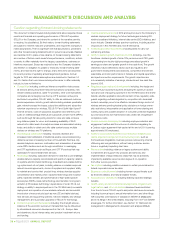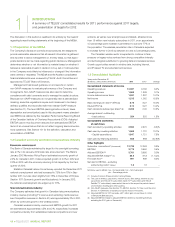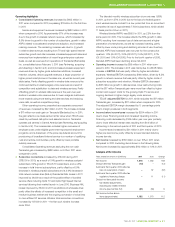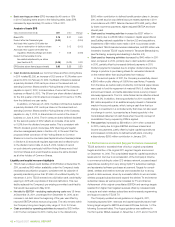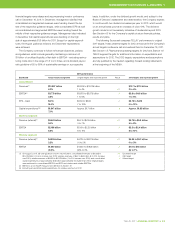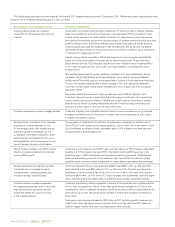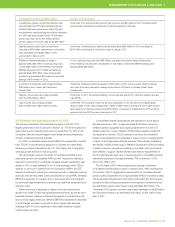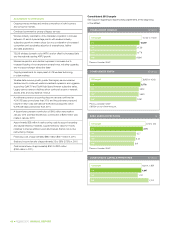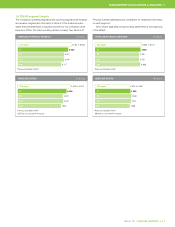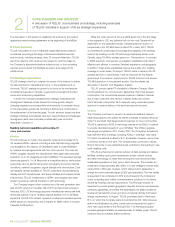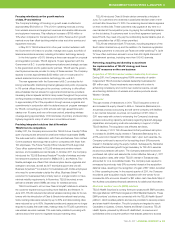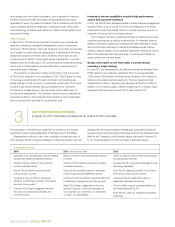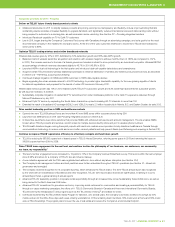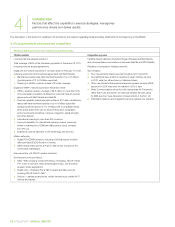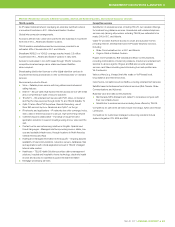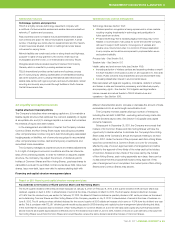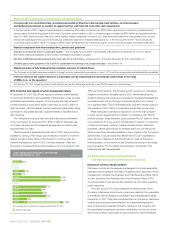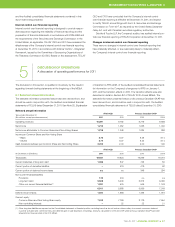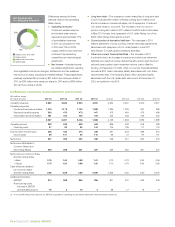Telus 2011 Annual Report Download - page 52
Download and view the complete annual report
Please find page 52 of the 2011 Telus annual report below. You can navigate through the pages in the report by either clicking on the pages listed below, or by using the keyword search tool below to find specific information within the annual report.
48 . TELUS 2011 ANNUAL REPORT
The discussion in this section is qualified in its entirety by the Caution
regarding forward-looking statements at the beginning of the MD&A.
2.1 Core business
TELUS Corporation is one of Canada’s largest telecommunications
companies, providing a full range of telecommunications services
and products, including wireless, data, IP, voice and television. TELUS
earns the majority of its revenue from access to, and the usage of,
the Company’s telecommunications infrastructure, or from providing
services and products that facilitate access to and usage of this
infrastructure.
2.2 Strategic imperatives
TELUS’ strategic intent is to unleash the power of the Internet to deliver
the best solutions to Canadians at home, in the workplace and on
the move. TELUS’ strategy for growth is to focus on its core telecom-
munications business in Canada, supported by international contact
centre and outsourcing capabilities.
In 2000, the Company developed six strategic imperatives that
management believes remain relevant for future growth, despite
changing regulatory and competitive environments. A consistent focus
on the imperatives guides the Company’s actions and contributes to
the achievement of its financial goals. To both advance these long-term
strategic initiatives and address near-term opportunities and challenges,
management sets new corporate priorities each year, as further
described in Section 3.
Building national capabilities across data, IP,
voice and wireless
Wireless
TELUS continues to invest in the capacity, speed and coverage of its
4G wireless HSPA+ network, including a dual-cell technology upgrade
now available to the majority of Canadians coast to coast facilitated
by network access agreements with two other carriers. The dual-cell
HSPA+ upgrade doubled the manufacturer-rated peak data download
speeds to up to 42 megabits per second (Mbps). The expected average
download speed is 7 to 14 Mbps with a compatible device, while actual
speed may vary by device being used, topography and environmental
conditions, network congestion, signal strength and other factors. Dual-
cell-capable devices available to TELUS’ customers include Samsung
Galaxy and HTC smartphones, and Sierra Wireless and Huawei mobile
Internet keys. TELUS’ investments in HSPA+ technologies have been
made to provide an optimal transition to LTE technology.
The Company began urban construction of its next generation wire-
less 4G LTE network in the latter half of 2011 and launched services in
February 2012. LTE technology supports manufacturer-rated peak data
download speeds of up to 75 Mbps (typical speeds of 12 to 25 Mbps
expected). TELUS’ LTE network operates on advanced wireless services
(AWS) spectrum, acquired by the Company for $882 million in Industry
Canada’s 2008 auction.
While the urban launch of 4G over AWS spectrum is the first stage
in the upgrade to LTE, any potential roll-out into rural Canada will be
dependent on the expected Industry Canada spectrum auction of
frequencies in the 700 MHz band in late 2012 or early 2013. TELUS
is committed to enhancing the coverage and capacity of its wireless
network by building out 4G LTE technology extensively across rural
Canada using 700 MHz wireless spectrum. This spectrum, in contrast
to AWS spectrum, has superior propagation capabilities that make it
effective and efficient in covering Canada’s expansive rural geography.
In addition, these same capabilities improve the quality of in-building
coverage in urban areas. To support TELUS’ plans to expand 4G LTE
wireless service to rural markets, it will be important for the federal
government to provide an opportunity for TELUS to bid on and acquire
700 MHz spectrum in the planned auction. See the related risk
discussion in Section 10.3 Regulatory matters.
TELUS’ primary cable-TV competitor in Western Canada, Shaw
Communications Inc., announced in September that it had stopped
construction of a conventional wireless network in Western Canada
due to high
costs and other factors. Instead, Shaw announced
that it will build
metropolitan Wi-Fi networks using unlicensed public
spectrum to extend delivery of its services beyond the home.
Wireline
The Company continues to invest in its wireline broadband network,
expanding capacity and speed, as well as coverage, including rolling out
Optik TV and Optik High Speed Internet services to more communities.
TELUS is deploying a VDSL2 technology overlay on its ADSL2+ network
to provide download speeds of up to 30 Mbps. The VDSL2 upgrade
was largely completed in 2011. In early 2012, the Company’s broadband
high-definition (HD) coverage, including ADSL2+ coverage, was nearly
2.3 million households in Alberta, B.C. and Eastern Quebec, up by close
to 200,000 homes in one year. The Company also continues to deploy
fibre to the home in new residential areas, and fibre to the building in new
multi-dwelling units.
TELUS is enhancing its national network of data centres and related
facilities, drawing upon green hydroelectric power, natural cooling
and other technology to make them among the most environmentally
sustainable operations of their type in North America. This includes an
investment of approximately $65 million in a new intelligent Internet data
centre (IDC) in Rimouski, Quebec, which will be built to leadership in
energy and environmental design (LEED) gold standards. The new facility
is expected to be completed in 2012 and will support the Company’s
cloud computing and unified communications solutions for its clients,
as well as meeting internal requirements. The Rimouski location is
expected to provide greater geographic diversity and improved business
continuity capabilities, and offers the advantages of a skilled workforce,
Quebec’s hydroelectric power grid and a moderate climate that lowers
energy requirements. In August, TELUS purchased land in Kamloops,
B.C. on which the Company plans to build another IDC. After site prep-
aration and finalization of plans, construction is expected to begin in
2012 with costs similar to the Rimouski IDC. The Kamloops location
provides geological stability, as well as access to reliable power, TELUS’
networks and an available skilled workforce.
2CORE BUSINESS AND STRATEGY
A discussion of TELUS’ core business and strategy, including examples
of TELUS’ activities in support of its six strategic imperatives


